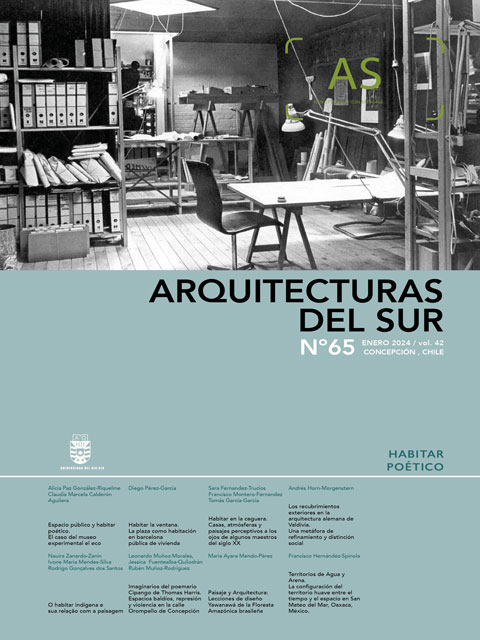Living in blindness. Houses, atmospheres, and perceptive landscapes through the eyes of some 20th-century masters
DOI:
https://doi.org/10.22320/07196466.2024.42.065.03Keywords:
blindness and living, perceptual landscapes, Chuck Yeager, Manuel Parra-Danilo Veras, Lewerentz-AnshelmAbstract
Jorge Luis Borges confessed, on more than one occasion, that his modest blindness was not the dramatic darkness that common sense believes but rather a refuge that, in his case, was built in a slow twilight. At the end of his speech to receive the Honoris Causa degree from the Faculty of Philosophy and Letters of the University of Chile, the Argentine writer spoke about the gradual parting of his sight and the pleasant sensation of entering a new, richer, deeper, and more creative living space. Relying on blindness as an introspective landscape, as a habitable space where fantasy meets realism, it is in this context that the essay proposes to inhabit, with thought, a weightless and infinite domestic space. Other artists achieved it - Groussac, Monet, Homer, Joyce, Herzog, Pallasmaa, and Italo Calvino - turning this kind of induced blindness into an intimate and creative room in which to settle at the end of their lives. Professor Yeager introduces this story, making us ascend to the heavens in search of an inspiring, black, and profound space. The house dreamed by Manuel Parra and Danilo Veras leads us away from the light to discover ourselves in a unique sensory experience. From the hand of the master Lewerentz, this essay will bring together some architectural experimentations with a singular dark box, an asphalt and black environment: black box in Lund. Living in blindness suggests a revision of our perceptual field, imaginatively inhabiting these introspective places where laws seem to have disappeared. Blindness, as Borges mentioned in that speech, makes the body join the space to dream of a new, more poetic, and creative dwelling (Figure 1).
Downloads
References
AHLIN, J. (1987). Sigurd Lewerentz, architect, 1885-1975. Byggförlaget.
BACHELARD, G. (1957). La Poética del Espacio. Fondo de Cultura Económica.
BORGES, J. (2000). Siete noches, Madrid: Ed. Alianza Editorial.
CALDENBY, C. (1998). El Nórdico Solitario. Revista Quaderns. (169-170), 106-134. https://raco.cat/index.php/QuadernsArquitecturaUrbanisme/article/view/204421.
CALVINO, I. (1998). Seis Propuestas para el Próximo Milenio.Siruela.
CRUZ, L. (2016). La casa en la Ciudad de México en el siglo XX. Un recorrido por sus espacios. Universidad Nacional Autónoma de México.
CURTIS, W. (2004). Sigurd Lewerentz. La neutralidad del orden. Revista A&V. (55). 42-45. https://arquitecturaviva.com/publicaciones/av-monografias/escandinavos
FERNÁNDER TRUCIO, S. (2023). Habitar el paisaje: del umbral de la vivienda unifamiliar a la colectiva, [Tesis de Doctorado no publicada]. Universidad de Sevilla.
FLAMMARION, C. (1902). La Atmósfera. Montaner y Simón.
GARCÍA, T. (2017). Cartografías del espacio oculto. Laboratorio de experimentación arquitectónica, [Tesis de Doctorado, no publicada]. Universidad de Sevilla.
HOLL, S. (2011). Cuestiones de Percepción. Fenomenología de la Arquitectura. Gustavo Gili.
HUTCHINSON, S. (1969). Mentor Inbound: The Authorized biography of Fred J. Ascani, Major General. Bartam Books.
KWINTER, S.(2002) ¿Cuándo empezó el futuro?, en KOOLHAAS, Rem, Conversaciones con estudiantes. Gustavo Gili.
LE BRETON, D. (2010). Cuerpo sensible. Metales Pesados.
MERLEAU PONTY, M. (1975). Fenomenología de la Percepción (1945). Península.
ORTIZ, V. (1984). La casa, una aproximación. Universidad Autónoma Metropolitana de Xochimilco
PALLASMAA, J. (2006). La mano que piensa. Gustavo Gili.
PEREC, G. (2001). Especies de Espacios. Montesinos.
SARAMAGO, J.(1995). Ensayo Sobre la Ceguera. Caminho
SARTRE, J. (1972). El Ser y la Nada. Losada.
SEGUÍ DE LA RIVA, J. (2001). Encuentros II (mayo 2001/agosto 2002). Cuadernos del Instituto Juan de Herrera (165.01). Instituto Juan de Herrera, ISBN 8497281063. https://oa.upm.es/54735/
TORRIJOS, P. (Anfitrión). (2023-presente). Como ser Pablo Palazuelo. (Podcast). Spreaker.https://www.spreaker.com/user/11299905/como-suena-edificio-13-pablo-palazuelo
YEAGER, CH. (1994). How to win a Dogfight. Men´s Health, (46), 56-68.
YEAGER, CH. (1965) Yeager. Bartam Books.
Downloads
Published
How to Cite
Issue
Section
License
Copyright (c) 2024 Sara Fernandez-Trucios, Francisco Javier Montero-Fernandez, Tomás García-García

This work is licensed under a Creative Commons Attribution-ShareAlike 4.0 International License.
The content of the articles published in each issue of Arquitecturas del Sur is the sole responsibility of the authors and does not necessarily represent the opinion of University of the Bío-Bío.
The authors will maintain their copyright; however, they will guarantee the journal the right to first publication and dissemination of their work. The publication of the article in Arquitecturas del Sur will be subject to the Creative Commons International license (CC BY-SA) that allows others to adapt: remix, transform and build on the material for any purpose, even commercially; share: copy and redistribute the material in any medium or format, as long as the authorship and first publication in this journal are acknowledged by citing them correctly, and their new contributions are under a license with the same terms.














 Programa de Información Científica/Concurso Fondos de Publicación de Revistas Científicas 2018/ Proyecto Mejoramiento de Visibilidad de Revistas UBB (Código:FP180007)
Programa de Información Científica/Concurso Fondos de Publicación de Revistas Científicas 2018/ Proyecto Mejoramiento de Visibilidad de Revistas UBB (Código:FP180007) 
